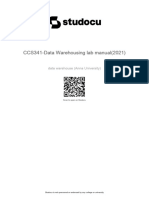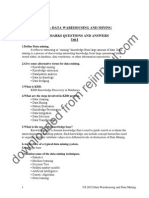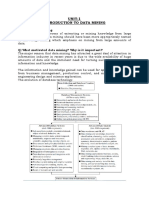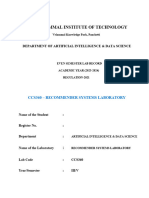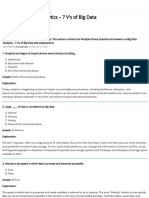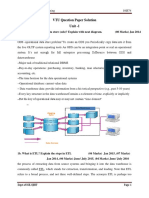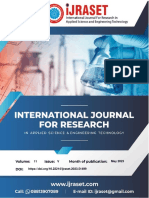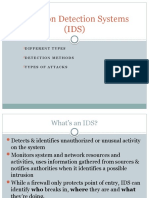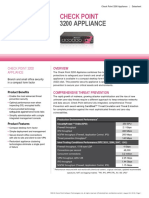0 ratings0% found this document useful (0 votes)
1K viewsTrends in Data Mining
Trends in Data Mining
Uploaded by
Lalitha NaiduThis document discusses 14 trends in data mining including: the integration of data mining with databases and web systems, standardization of data mining languages, visual and distributed data mining methods, mining complex data types like graphs and biological data, and real-time data mining. It also summarizes applications of data mining in finance, retail, telecommunications, biology, science, and intrusion detection. Finally, it outlines theoretical foundations, statistical techniques, visual data mining, collaborative filtering, and security aspects of data mining.
Copyright:
© All Rights Reserved
Available Formats
Download as PDF, TXT or read online from Scribd
Trends in Data Mining
Trends in Data Mining
Uploaded by
Lalitha Naidu0 ratings0% found this document useful (0 votes)
1K views9 pagesThis document discusses 14 trends in data mining including: the integration of data mining with databases and web systems, standardization of data mining languages, visual and distributed data mining methods, mining complex data types like graphs and biological data, and real-time data mining. It also summarizes applications of data mining in finance, retail, telecommunications, biology, science, and intrusion detection. Finally, it outlines theoretical foundations, statistical techniques, visual data mining, collaborative filtering, and security aspects of data mining.
Original Title
Trends in Data Mining(1)
Copyright
© © All Rights Reserved
Available Formats
PDF, TXT or read online from Scribd
Share this document
Did you find this document useful?
Is this content inappropriate?
This document discusses 14 trends in data mining including: the integration of data mining with databases and web systems, standardization of data mining languages, visual and distributed data mining methods, mining complex data types like graphs and biological data, and real-time data mining. It also summarizes applications of data mining in finance, retail, telecommunications, biology, science, and intrusion detection. Finally, it outlines theoretical foundations, statistical techniques, visual data mining, collaborative filtering, and security aspects of data mining.
Copyright:
© All Rights Reserved
Available Formats
Download as PDF, TXT or read online from Scribd
Download as pdf or txt
0 ratings0% found this document useful (0 votes)
1K views9 pagesTrends in Data Mining
Trends in Data Mining
Uploaded by
Lalitha NaiduThis document discusses 14 trends in data mining including: the integration of data mining with databases and web systems, standardization of data mining languages, visual and distributed data mining methods, mining complex data types like graphs and biological data, and real-time data mining. It also summarizes applications of data mining in finance, retail, telecommunications, biology, science, and intrusion detection. Finally, it outlines theoretical foundations, statistical techniques, visual data mining, collaborative filtering, and security aspects of data mining.
Copyright:
© All Rights Reserved
Available Formats
Download as PDF, TXT or read online from Scribd
Download as pdf or txt
You are on page 1of 9
2.
4 TRENDS IN DATA MINING
1. Application exploration: Early data mining applications focused mainly on
helping businesses gain a competitive edge.
2. Scalable and interactive data mining methods: In contrast with traditional data
analysis methods, data mining must be able to handle huge amounts of data
efficiently and, if possible, interactively.
3. Integration of data mining with database systems, data warehouse systems,
and Web database systems: Database systems, data warehouse systems, and the
Web have become mainstream information processing systems.
4. Standardization of data mining language: A standard data mining language or
other standardization efforts will facilitate the systematic development of data
mining solutions, improve interoperability among multiple data mining systems
and functions, and promote the education and use of data mining systems in
industry and society.
5. Visual data mining: Visual data mining is an effective way to discover
knowledge fromhuge amounts of data
6. Biological data mining: Although biological data mining can be considered
under application exploration or mining complex types of data, the unique
combination of complexity, richness, size, and importance of biological data
warrants special attention in data mining.
7. Data mining and software engineering: As software programs become
increasingly bulky in size, sophisticated in complexity, and tend to originate from
the integration of multiple components developed by different software teams, it
is an increasingly challenging task to ensure software robustness and reliability.
8. Web mining: Web mining is the application of data mining techniques to
discover patterns from the Web. According to analysis targets, web mining can be
divided into three different types, which are Web usage mining, Web content
mining and Web structure mining.
9. Distributed data mining: Traditional data mining methods, designed to work at
a centralized location, do not work well in many of the distributed computing
environments present today (e.g., the Internet, intranets, local area networks,
high-speed wireless networks, and sensor networks). Advances in distributed data
mining methods are expected.
10. Real-time or time-critical data mining: Many applications involving stream
data (such as e-commerce, Web mining, stock analysis, intrusion detection,
mobile data mining, and data mining for counterterrorism) require dynamic data
mining models to be built in real time. Additional development is needed in this
area.
11.Graph mining, link analysis, and social network analysis: Graph mining, link
analysis, and social network analysis are useful for capturing sequential,
topological, geometric, and other relational characteristics of many scientific data
sets (such as for chemical compounds and biological networks) and social data
sets (such as for the analysis of hidden criminal networks)
12. Multi relational and multi database data mining: Most data mining
approaches search for patterns in a single relational table or in a single database.
However, most real world data and information are spread across multiple tables
and databases.
13. New methods for mining complex types of data: mining complex types of
data is an important research frontier in data mining. Although progress has been
made in mining stream, time-series, sequence, graph, spatiotemporal,
multimedia, and text data, there is still a huge gap between the needs for these
applications and the available technology.
14. Privacy protection and information security in data mining: An abundance of
recorded personal information available in electronic forms and on the Web,
coupled with increasingly powerful data mining tools, poses a threat to our
privacy and data security
2.5 APPLICATIONS OF DATA MINING
Data Mining for Financial Data Analysis few typical cases:
1. Design and construction of data warehouses for multidimensional data
analysis and data mining
2. Loan payment prediction and customer credit policy analysis
3. Classification and clustering of customers for targeted marketing
4. Detection of money laundering and other financial crimes
5. Data Mining for the Retail Industry
A few examples of data mining in the retail industry:
1. Design and construction of data warehouses based on the benefits of data
mining
2. Multidimensional analysis of sales, customers, products, time, and region
3. Analysis of the effectiveness of sales campaigns
4. Customer retentionanalysis of customer loyalty
5. Product recommendation and cross-referencing of items
Data Mining for the Telecommunication Industry
1. Multidimensional analysis of telecommunication data
2. Fraudulent pattern analysis and the identification of unusual patterns
3. Multidimensional association and sequential pattern analysis:
4. Mobile telecommunication services
5. Use of visualization tools in telecommunication data analysis
Data Mining for Biological Data Analysis
1. Semantic integration of heterogeneous, distributed genomic and proteomic
databases
2. Alignment, indexing, similarity search, and comparative analysis of multiple
nucleotide/
protein sequences
3. Discovery of structural patterns and analysis of genetic networks and
protein pathways
4. Association and path analysis: identifying co-occurring gene sequences and
linking genes to different stages of disease development
5. Visualization tools in genetic data analysis
Data Mining in Other Scientific Applications
Data collection and storage technologies have recently improved, so that
today, scientific data can be amassed at much higher speeds and lower costs. This
has resulted in the accumulation of huge volumes of high-dimensional data,
stream data, and heterogeneous data, containing rich spatial and temporal
information. Consequently, scientific applications are shifting from the
hypothesize-and-test paradigm toward a collect and store data, mine for new
hypotheses, confirm with data or experimentation process. This shift brings
about new challenges for data mining.
Challenges:
1. Data warehouses and data preprocessing
2. Mining complex data types
3. Graph-based mining
4. Visualization tools and domain-specific knowledge
Data Mining for Intrusion Detection
The security of our computer systems and data is at continual risk. The extensive
growth of the Internet and increasing availability of tools and tricks for intruding
and attacking networks have prompted intrusion detection to become a critical
component of network administration.
The following are areas in which data mining technology may be applied or
further developed for intrusion detection:
1. Development of data mining algorithms for intrusion detection
2. Association and correlation analysis, and aggregation to help select and
build discriminating attributes
3. Analysis of stream data
4. Distributed data mining
5. Visualization and querying tools
Data Mining System Products and Research Prototypes data mining systems
should be assessed based on the following multiple features:
1. Data types
2. System issues
3. Data sources
4. Data mining functions and methodologies.
5. Coupling data mining with database and/or data warehouse systems.
6. Scalability
7. Visualization tools
8. Data mining query language and graphical user interface:
Additional Themes on Data Mining: Theoretical Foundations of Data Mining
1. Data reduction: In this theory, the basis of data mining is to reduce the
data representation
2. Data compression: According to this theory, the basis of data mining is to
compress the given data by encoding in terms of bits, association rules,
decision trees, clusters, and so on
3. Pattern discovery: In this theory, the basis of data mining is to discover
patterns occurring in the database, such as associations, classification
models, sequential patterns, and so on
4. Probability theory: This is based on statistical theory. In this theory, the
basis of data mining is to discover joint probability distributions of random
variables, for example, Bayesian belief networks or hierarchical Bayesian
models.
5. Microeconomic view: The microeconomic view considers data mining as
the task of finding patterns that are interesting only to the extent that they
can be used in the decision making process of some enterprise (e.g.,
regarding marketing strategies and production plans).
6. Inductive databases: According to this theory, a database schema consists
of data and patterns that are stored in the database.
Statistical Data Mining techniques:
1. Regression
2. Generalized linear model
3. Analysis of variance
4. Mixed effect model
5. Factor analysis
6. Discriminate analysis
7. Time series analysis
8. Survival analysis
9. Quality control
Visual and Audio Data Mining
Visual data mining discovers implicit and useful knowledge from large data sets
using data and/or knowledge visualization techniques.
In general, data visualization and data mining can be integrated in the following
ways:
1. Data visualization
2. Data mining result visualization
3. Data mining process visualization
4. Interactive visual data mining
Data Mining and Collaborative Filtering
A collaborative filtering approach is commonly used, in which products are
recommended based on the opinions of other customers. Collaborative
recommender systems may employ data mining or statistical techniques to search
for similarities among customer preferences.
Security of Data Mining
Data securityenhancing techniques have been developed to help protect data.
Databases can employ a multilevel security model to classify and restrict data
according to various security levels, with users permitted access to only their
authorized level. Privacy-sensitive data mining deals with obtaining valid data
mining results without learning the underlying data values.
You might also like
- Unit-3 DSDocument21 pagesUnit-3 DSrajkumarmtechNo ratings yet
- Question BankDocument14 pagesQuestion BankVinayak PhutaneNo ratings yet
- CCS341-Data Warehousing Lab Manual (2021)Document50 pagesCCS341-Data Warehousing Lab Manual (2021)dev684986No ratings yet
- Unit 2Document32 pagesUnit 2Akash Varma JampanaNo ratings yet
- CS2032 2 Marks & 16 Marks With AnswersDocument30 pagesCS2032 2 Marks & 16 Marks With AnswersThiyagarajan Ganesan100% (1)
- Data Mining and Visualization Question BankDocument11 pagesData Mining and Visualization Question Bankghost100% (1)
- Feature Creation in Data MiningDocument5 pagesFeature Creation in Data Miningvijayesh ayuNo ratings yet
- MA7155-Applied Probability and Statistics Question BankDocument15 pagesMA7155-Applied Probability and Statistics Question Bankselvakrishnan_sNo ratings yet
- UNIT-1 Introduction To Data MiningDocument29 pagesUNIT-1 Introduction To Data MiningVedhaVyas MahasivaNo ratings yet
- PAT Trees and PAT ArraysDocument12 pagesPAT Trees and PAT ArraysSantosh JhansiNo ratings yet
- CCS360 Lab RecordDocument28 pagesCCS360 Lab RecordpadmapriyaNo ratings yet
- r18 - Big Data Analytics - Cse (DS)Document1 pager18 - Big Data Analytics - Cse (DS)aarthi dev0% (1)
- Data Visualization and Story Telling NotesDocument31 pagesData Visualization and Story Telling Notesaakash vermaNo ratings yet
- AD3251 Data Structures Design Question Bank 1Document1 pageAD3251 Data Structures Design Question Bank 1bbook6930No ratings yet
- 5.5.2 Video To Text With LSTM ModelsDocument10 pages5.5.2 Video To Text With LSTM ModelsNihal ReddyNo ratings yet
- UNIT-2: Introduction To Searching Methods in AIDocument46 pagesUNIT-2: Introduction To Searching Methods in AIminNo ratings yet
- ML Unit 1Document13 pagesML Unit 12306603No ratings yet
- Introduction To Data Science With R Programming Language Lab RecordDocument20 pagesIntroduction To Data Science With R Programming Language Lab RecordLakshmi sarvani videla Lecturer in Computer ScienceNo ratings yet
- Data Mining NotesDocument75 pagesData Mining NotesAravind RossiNo ratings yet
- Data Structures Unit I NotesDocument16 pagesData Structures Unit I NotesbalaNo ratings yet
- Daa Lab Manual Program 2021-2022Document47 pagesDaa Lab Manual Program 2021-2022UMA SIKAMANINo ratings yet
- ESDL Lab ManualDocument7 pagesESDL Lab Manualanbhute3484No ratings yet
- Fundamentals of Data Science: Nehru Institute of Engineering and TechnologyDocument17 pagesFundamentals of Data Science: Nehru Institute of Engineering and Technologysakthisubi100% (1)
- Notes On Computer Networks Unit 3Document13 pagesNotes On Computer Networks Unit 3Rohit Chaudhary83% (6)
- Query Languages and Query Operation: Chapter SevenDocument20 pagesQuery Languages and Query Operation: Chapter Sevenmilkikoo shiferaNo ratings yet
- DbmsDocument99 pagesDbmspalaniperumal041979No ratings yet
- Co-Po Big Data AnalyticsDocument41 pagesCo-Po Big Data AnalyticssuniNo ratings yet
- ReLu Heuristics For Avoiding Local Bad MinimaDocument10 pagesReLu Heuristics For Avoiding Local Bad MinimaShanmuganathan V (RC2113003011029)100% (2)
- MCQs - Big Data Analytics - 7 V's of Big DataDocument7 pagesMCQs - Big Data Analytics - 7 V's of Big DataZuniButtNo ratings yet
- Scoa Unit I MCQ: FalseDocument33 pagesScoa Unit I MCQ: FalseShruti KohakadeNo ratings yet
- JNTUK R20 ML UNIT-I (Chapter-I)Document9 pagesJNTUK R20 ML UNIT-I (Chapter-I)chaitanyachaituluckyNo ratings yet
- Data Mining PDFDocument67 pagesData Mining PDFNaveen SettyNo ratings yet
- DBMS-Unit 5Document27 pagesDBMS-Unit 5ABRNo ratings yet
- Machine Learning Question Paper 21 22Document3 pagesMachine Learning Question Paper 21 22mrvishalyadav0No ratings yet
- Data Mining-Graph MiningDocument9 pagesData Mining-Graph MiningRaj EndranNo ratings yet
- Binary Search Tree: Reny JoseDocument36 pagesBinary Search Tree: Reny JoseReny JoseNo ratings yet
- Data Structure Unit 5 (Searching and Sorting Notes)Document26 pagesData Structure Unit 5 (Searching and Sorting Notes)RANJAN MISHRANo ratings yet
- Algebraic Structures: Algebraic Systems Semi Groups Monoids Groups Sub Groups Homomorphism IsomorphismDocument43 pagesAlgebraic Structures: Algebraic Systems Semi Groups Monoids Groups Sub Groups Homomorphism IsomorphismManvitha Reddy Sama0% (1)
- UNIT - IV - Syllabus The Collections Framework (Java - Util)Document24 pagesUNIT - IV - Syllabus The Collections Framework (Java - Util)Vikram JhaNo ratings yet
- Data-Structures-Lecture 1Document12 pagesData-Structures-Lecture 1Zakir HossenNo ratings yet
- Find S AlgorithmDocument7 pagesFind S AlgorithmPooja DixitNo ratings yet
- Data Structure and Algorithm (LAB MANUAL)Document40 pagesData Structure and Algorithm (LAB MANUAL)Niaz Ahmed Khan100% (1)
- CN - 2 Marks Questions and SolutionsDocument23 pagesCN - 2 Marks Questions and Solutionsaccessgm100% (4)
- Software Testing Lab Manual 2Document46 pagesSoftware Testing Lab Manual 2Arya Raju100% (2)
- Unit I Content Beyond Syllabus - I Introduction To Data Mining and Data Warehousing What Are Data Mining and Knowledge Discovery?Document12 pagesUnit I Content Beyond Syllabus - I Introduction To Data Mining and Data Warehousing What Are Data Mining and Knowledge Discovery?ShanmugapriyaVinodkumarNo ratings yet
- Issues in Knowledge Representation: InversesDocument4 pagesIssues in Knowledge Representation: InversesSenthil MuruganNo ratings yet
- File Organization in DBMSDocument23 pagesFile Organization in DBMSsunny sarwara100% (1)
- Dbms Vtu NotesDocument104 pagesDbms Vtu NotessatyaNo ratings yet
- Text Processing and Pattern Searching: Chapter - 6Document34 pagesText Processing and Pattern Searching: Chapter - 6prasannakompalli100% (2)
- DVT - Question BankDocument3 pagesDVT - Question Bankdineshqkumarq100% (1)
- Cognitive Science ManualDocument17 pagesCognitive Science Manualcse girlsNo ratings yet
- Web Lab Question BankDocument2 pagesWeb Lab Question Banklolman100% (1)
- MCQDocument4 pagesMCQspraveen2007No ratings yet
- CS3401 Algorithms Lecture Notes 1Document132 pagesCS3401 Algorithms Lecture Notes 1vkarthika7482No ratings yet
- Ad3491 Fdsa Unit 2 Notes EduenggDocument82 pagesAd3491 Fdsa Unit 2 Notes Eduenggarul mamceNo ratings yet
- Whats AppDocument23 pagesWhats AppRâjä SékhãrNo ratings yet
- Data Mining: An Overview From Database Perspective: Index TermsDocument41 pagesData Mining: An Overview From Database Perspective: Index TermsJaison JustusNo ratings yet
- DMW UNIT 1 PessondranathDocument29 pagesDMW UNIT 1 Pessondranath2344Atharva PatilNo ratings yet
- 1.1 Introduction To Data Mining: 1.1.1 Moving Toward The Information AgeDocument14 pages1.1 Introduction To Data Mining: 1.1.1 Moving Toward The Information AgeSonga SowjanyaNo ratings yet
- DWDM Unit3Document15 pagesDWDM Unit3khushipanwar690No ratings yet
- Informatica PowerCenter - The Complete Reference 2Document4 pagesInformatica PowerCenter - The Complete Reference 2Lalitha NaiduNo ratings yet
- Gap Affidavit SampleDocument1 pageGap Affidavit SampleLalitha NaiduNo ratings yet
- Efficient Claim SysDocument63 pagesEfficient Claim SysLalitha NaiduNo ratings yet
- Robust Video Data Hiding Using Forbidden Data HidingDocument5 pagesRobust Video Data Hiding Using Forbidden Data HidingLalitha NaiduNo ratings yet
- C Q Aan12sDocument60 pagesC Q Aan12sLalitha NaiduNo ratings yet
- Improved Binary Gray Wolf Optimizer and SVM For Intrusion Detection System in Wireless Sensor NetworksDocument19 pagesImproved Binary Gray Wolf Optimizer and SVM For Intrusion Detection System in Wireless Sensor NetworkskishoreNo ratings yet
- Ids IpsDocument56 pagesIds Ipsez8qgk6yNo ratings yet
- PCI Data Security Standard (PCI DSS) PDFDocument34 pagesPCI Data Security Standard (PCI DSS) PDFmarcelNo ratings yet
- Cisco Wireless NetworkDocument464 pagesCisco Wireless Networkap00No ratings yet
- Security + Study GuideDocument59 pagesSecurity + Study GuideDavid EdwardNo ratings yet
- Kamaldeep, 2021Document12 pagesKamaldeep, 2021Faisal AliNo ratings yet
- Jiw 19.3 0Document138 pagesJiw 19.3 0Teppo TammivuoriNo ratings yet
- A Survey On Intrusion Detection System Using Machine Learning TechniquesDocument7 pagesA Survey On Intrusion Detection System Using Machine Learning TechniquesIJRASETPublicationsNo ratings yet
- RFP For Procurement and Management of Cyber Security ComponentDocument181 pagesRFP For Procurement and Management of Cyber Security ComponentDivyanshu AnkitNo ratings yet
- Firewall Locations and ConfigurationsDocument39 pagesFirewall Locations and Configurationsami_haroonNo ratings yet
- Vmware NSX DatasheetDocument8 pagesVmware NSX DatasheetДејан СенићNo ratings yet
- Palo Alto Networks Vs FortinetDocument2 pagesPalo Alto Networks Vs FortinetRenato100% (1)
- Chapter 3 InternetDocument29 pagesChapter 3 InternetPurvaNo ratings yet
- A Day in The Life of A SOC AnalystDocument4 pagesA Day in The Life of A SOC AnalystDave SeynabouNo ratings yet
- VOD-5514 - Defensive Security ConceptsDocument140 pagesVOD-5514 - Defensive Security Conceptscapeb74220No ratings yet
- INST BHI8x10x InstStd Guide 080109 Rev1Document145 pagesINST BHI8x10x InstStd Guide 080109 Rev1Анатолий МаловNo ratings yet
- Intrusion Detection Systems (IDS) : Different Types Detection Methods Types of AttacksDocument21 pagesIntrusion Detection Systems (IDS) : Different Types Detection Methods Types of AttacksBryan AscherNo ratings yet
- CIS Controls v8 and Mapping To ISO27002Document132 pagesCIS Controls v8 and Mapping To ISO27002Dark Storm WolfNo ratings yet
- Checkpoint 3200 Appliance DatasheetDocument3 pagesCheckpoint 3200 Appliance Datasheetvuabai racNo ratings yet
- CCNASv2 InstructorPPT CH5Document70 pagesCCNASv2 InstructorPPT CH5Anonymous a0Fij1No ratings yet
- Honeypots As A Security Mechanism (IEEE)Document6 pagesHoneypots As A Security Mechanism (IEEE)hajistha09No ratings yet
- KR MARITIME CYBER SAFETY NEWS Vol. 047 - ENDocument22 pagesKR MARITIME CYBER SAFETY NEWS Vol. 047 - ENAlexander NikolaevNo ratings yet
- Ids Ips FWDocument34 pagesIds Ips FWShady El-MalataweyNo ratings yet
- ART An Attack-Resistant Trust ManagementDocument10 pagesART An Attack-Resistant Trust ManagementDeepak StallioneNo ratings yet
- Network - Assignment 0001 (1) 1Document58 pagesNetwork - Assignment 0001 (1) 1Malshi DilinikaNo ratings yet
- Aws NotesDocument10 pagesAws NotesJuan Esteban Vélez MuñozNo ratings yet
- 210-250 Dump Ans by Lead 2 PassDocument22 pages210-250 Dump Ans by Lead 2 Passrita100% (1)
- Corelight-And-cPacket Proactive Cybersecurity SolutionBriefDocument2 pagesCorelight-And-cPacket Proactive Cybersecurity SolutionBriefAltafSaifNo ratings yet
- CYB 220 Module Five Hamza EchcheikhiDocument6 pagesCYB 220 Module Five Hamza Echcheikhihamza.echcheikhiNo ratings yet
- UNSW-NB15: A Comprehensive Data Set For Network Intrusion Detection Systems (UNSW-NB15 Network Data Set)Document7 pagesUNSW-NB15: A Comprehensive Data Set For Network Intrusion Detection Systems (UNSW-NB15 Network Data Set)Наталия СтруковаNo ratings yet


